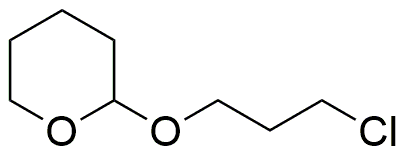2-(3-Chloropropoxy)tetrahydro-2H-pyran is widely utilized in research focused on:
- Pharmaceutical Development: This compound serves as an intermediate in the synthesis of various pharmaceuticals, particularly in developing drugs that target specific biological pathways.
- Agricultural Chemicals: It is used in formulating agrochemicals, enhancing the efficacy of pesticides and herbicides by improving their solubility and absorption in plants.
- Polymer Chemistry: This chemical acts as a building block in creating specialty polymers, contributing to materials with unique properties such as flexibility and chemical resistance.
- Research Reagents: It is employed as a reagent in organic synthesis, facilitating the creation of complex molecules in laboratory settings, which is crucial for academic and industrial research.
- Cosmetic Formulations: The compound is also found in cosmetic products, where it helps to enhance the texture and stability of formulations, making them more appealing to consumers.
General Information
Properties
Safety and Regulations
Applications
2-(3-Chloropropoxy)tetrahydro-2H-pyran is widely utilized in research focused on:
- Pharmaceutical Development: This compound serves as an intermediate in the synthesis of various pharmaceuticals, particularly in developing drugs that target specific biological pathways.
- Agricultural Chemicals: It is used in formulating agrochemicals, enhancing the efficacy of pesticides and herbicides by improving their solubility and absorption in plants.
- Polymer Chemistry: This chemical acts as a building block in creating specialty polymers, contributing to materials with unique properties such as flexibility and chemical resistance.
- Research Reagents: It is employed as a reagent in organic synthesis, facilitating the creation of complex molecules in laboratory settings, which is crucial for academic and industrial research.
- Cosmetic Formulations: The compound is also found in cosmetic products, where it helps to enhance the texture and stability of formulations, making them more appealing to consumers.
Documents
Safety Data Sheets (SDS)
The SDS provides comprehensive safety information on handling, storage, and disposal of the product.
Product Specification (PS)
The PS provides a comprehensive breakdown of the product’s properties, including chemical composition, physical state, purity, and storage requirements. It also details acceptable quality ranges and the product's intended applications.
Certificates of Analysis (COA)
Search for Certificates of Analysis (COA) by entering the products Lot Number. Lot and Batch Numbers can be found on a product’s label following the words ‘Lot’ or ‘Batch’.
*Catalog Number
*Lot Number
Certificates Of Origin (COO)
This COO confirms the country where the product was manufactured, and also details the materials and components used in it and whether it is derived from natural, synthetic, or other specific sources. This certificate may be required for customs, trade, and regulatory compliance.
*Catalog Number
*Lot Number
Safety Data Sheets (SDS)
The SDS provides comprehensive safety information on handling, storage, and disposal of the product.
DownloadProduct Specification (PS)
The PS provides a comprehensive breakdown of the product’s properties, including chemical composition, physical state, purity, and storage requirements. It also details acceptable quality ranges and the product's intended applications.
DownloadCertificates of Analysis (COA)
Search for Certificates of Analysis (COA) by entering the products Lot Number. Lot and Batch Numbers can be found on a product’s label following the words ‘Lot’ or ‘Batch’.
*Catalog Number
*Lot Number
Certificates Of Origin (COO)
This COO confirms the country where the product was manufactured, and also details the materials and components used in it and whether it is derived from natural, synthetic, or other specific sources. This certificate may be required for customs, trade, and regulatory compliance.

